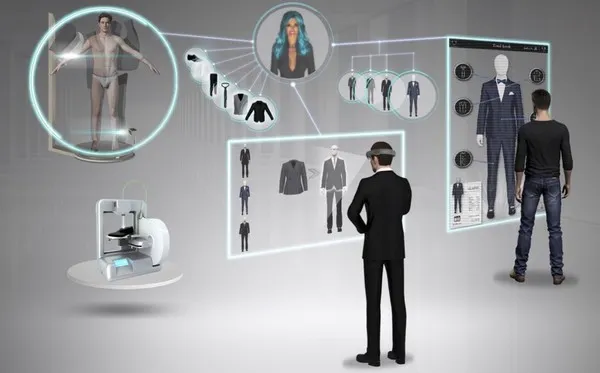In a world where technology is constantly evolving, the fashion industry has not been left behind. From cutting-edge materials to advanced manufacturing techniques, technology has revolutionized the way clothing is designed and produced. Join us as we delve into the exciting realm of fashion innovation and discover how technology has transformed the landscape of clothing design and manufacturing.
– Integration of 3D Printing in Fashion Design
With the integration of 3D printing in fashion design, the landscape of clothing design and manufacturing has been revolutionized. This innovative technology has allowed designers to push the boundaries of what is possible, creating intricate and unique pieces that were once thought to be impossible to produce.
One of the key benefits of 3D printing in fashion design is the ability to create customizable clothing and accessories. This technology allows designers to tailor garments to the exact measurements of individual customers, ensuring a perfect fit every time. Additionally, 3D printing allows for the production of complex geometries and intricate patterns that would be extremely difficult to achieve using traditional manufacturing methods.
Furthermore, 3D printing offers a more sustainable approach to fashion design and manufacturing. By using additive manufacturing techniques, designers can reduce waste and energy consumption, making the industry more environmentally friendly. This shift towards sustainability is crucial in the current climate crisis, and 3D printing is helping to lead the way towards a more eco-friendly future in fashion.
In conclusion, the integration of 3D printing in fashion design has brought about a new era of innovation and creativity in the industry. This technology has opened up endless possibilities for designers to create truly one-of-a-kind pieces, while also promoting sustainability and customization. With 3D printing at the forefront of fashion design, the future looks bright for the industry as a whole.
– Advancements in Sustainable Fabric Production
In recent years, the fashion industry has seen a significant shift towards sustainable fabric production. With advancements in technology, clothing designers and manufacturers are now able to create innovative and eco-friendly materials that are not only stylish but also environmentally conscious.
One of the key drivers of this movement is the development of new materials such as organic cotton, recycled polyester, and lyocell which are derived from natural sources and have a lower impact on the environment compared to traditional fabrics. These sustainable fabrics are not only better for the planet but also offer consumers a more ethical choice when it comes to their wardrobe.
Furthermore, technology has also played a crucial role in improving the production processes of these sustainable fabrics. Innovations such as waterless dyeing techniques and digital printing have helped reduce the environmental footprint of clothing manufacturing, making it more sustainable and efficient.
As consumers become more conscious about the impact of their purchases, the fashion industry continues to innovate and adopt sustainable practices in fabric production. With technology driving these advancements, the future of fashion looks greener and more environmentally friendly than ever before.
– Automation and Robotics in Clothing Manufacturing
In the world of fashion, innovation is constantly changing the way clothing is designed and manufactured. One of the most significant advancements in recent years is the integration of automation and robotics in clothing manufacturing. This fusion of technology has revolutionized the industry, leading to faster production times, increased efficiency, and improved overall quality.
Automation and robotics have enabled clothing manufacturers to streamline their processes, reducing the margin of error and ultimately increasing productivity. With the use of cutting-edge machinery, tasks that once required manual labor can now be completed with precision and speed. This not only benefits the manufacturers by saving time and resources but also results in higher-quality garments for consumers.
By incorporating automation and robotics into clothing manufacturing, companies are able to stay ahead of the curve in a rapidly evolving industry. Technology allows for customization on a mass scale, giving designers the freedom to experiment with new concepts and materials. Ultimately, this fusion of fashion and technology is shaping the future of clothing design and production, paving the way for even more innovative creations to come.
– Virtual Reality in Fashion Retail and Consumer Experience
Technology has revolutionized the fashion industry, changing the way clothing design and manufacturing are approached. With the introduction of virtual reality (VR) in fashion retail and consumer experience, the possibilities are endless.
One of the key benefits of incorporating VR into fashion is the ability to provide customers with a more immersive shopping experience. By creating virtual fitting rooms, shoppers can try on clothes without ever stepping foot in a physical store. This not only enhances the convenience for consumers but also reduces the need for physical inventory, saving space and costs for retailers.
Moreover, virtual reality has enabled designers to experiment with innovative designs and materials in a virtual environment, allowing for greater creativity and efficiency in the manufacturing process. With VR technology, designers can visualize their creations in 3D, making it easier to make adjustments and improvements before production. As a result, fashion brands can deliver more unique and personalized products to their customers, ultimately enhancing the overall shopping experience. In conclusion, the marriage of fashion and technology has revolutionized the way we design and produce clothing. From 3D printing to virtual fitting rooms, the possibilities are endless for pushing the boundaries of creativity in the fashion industry. As we continue to embrace innovation, we can only imagine the exciting and transformative changes that lie ahead for the world of clothing design and manufacturing. The future of fashion is bright, and technology will undoubtedly play a significant role in shaping it. Let’s embrace the future together and see where this journey takes us. Fashion forward, indeed.


